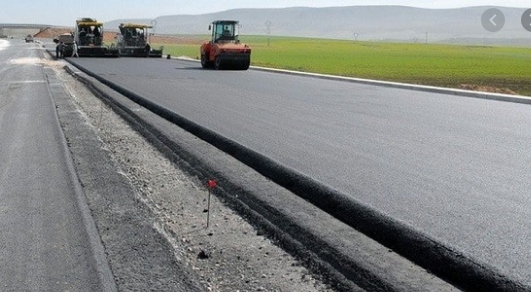Bituminous roads, also known as asphalt roads, are one of the most common types of roads in use today. These roads are made of a mixture of bitumen, which is a viscous, black, and sticky substance, and aggregate materials such as gravel, sand, or stone. The bitumen acts as a binder, holding the aggregate materials together and creating a durable and flexible surface. In this article, we will discuss the types of bituminous roads and the construction procedure involved in their construction.
Types of Bituminous Roads
There are three main types of bituminous roads, which differ in their composition and the size of the aggregate used.
Dense Bituminous Macadam (DBM):
DBM is made up of a dense mix of large-sized aggregates (ranging from 20mm to 40mm) and a binder material (bitumen). This type of road is commonly used for heavy traffic areas such as highways and main roads due to its high load-bearing capacity.
Bituminous Concrete (BC):
BC is made up of a mix of smaller-sized aggregates (ranging from 10mm to 20mm) and a binder material (bitumen). This type of road is commonly used for low- to medium-traffic areas such as residential roads, parking lots, and driveways.
Open-Graded Bituminous Concrete (OGBC):
OGBC is made up of a mix of very small-sized aggregates (ranging from 5mm to 10mm) and a binder material (bitumen). This type of road is commonly used for areas that need good drainage and noise reduction properties, such as airport runways and urban areas.
Construction Procedure for Bituminous Roads
The construction of bituminous roads involves several steps, which are discuss below:
Survey and Staking:
The first step in the construction of bituminous roads is to survey the site and stake out the road alignment. The alignment is determin bas on the traffic requirements and the terrain of the area.
Clearing and Grubbing: The next step is to clear and grub the area of any vegetation, trees, stumps, and debris that might be present.
Earthwork:
The earthwork involves the excavation and grading of the subgrade to the required level and slope. The subgrade should well-compacte to provide a stable base for the road.
Sub-base:
The sub-base is the layer of material place on top of the subgrade, which serves as a transition layer between the subgrade and the base course. It provides additional strength, stability, and drainage. The sub-base layer can made of crush stone, gravel, or recycled concrete.
Base Course:
The base course is the layer of material place on top of the sub-base, which serves as the main structural support for the road. The base course typically made of dense-grad aggregate, which is mix with the bitumen binder in a hot mix plant. The mixture is then transporte to the construction site and spread and compacted using a roller.
Binder Course:
The binder course is the layer of material place on top of the base course, which acts as an intermediate layer between the base course and the surface course. The binder course typically made of a coarser mix of aggregates than the surface course, mix with bitumen binder in a hot mix plant. The mixture then transported to the construction site and spread and compacted using a roller.
Surface Course:
The surface course is the final layer of material place on top of the binder course, which provides a smooth riding surface for the road. The surface course typically made of a finer mix of aggregates than the binder course, mixed with bitumen binder in a hot mix plant. The mixture then transported to the construction site and spread and compacted using a roller.
Pavement Markings and Signage:
Once the surface course has been laid and compacted, pavement markings and signage add to the road to provide guidance and information to drivers.
Quality Control:
Throughout the construction process, quality control measures are taken to ensure that the road construction to the required specifications. Samples of the mix taken and test to ensure that the mix design meets the required standards.
Advantages of Bituminous Roads
There are several advantages of bituminous roads, which include:
Smooth Riding Surface: Bituminous roads provide a smooth riding surface, which reduces driver fatigue and increases safety.
Flexibility: Bituminous roads are flexible and can accommodate changes in temperature and traffic loads without cracking.
Durability: Bituminous roads are durable and can withstand heavy traffic loads and adverse weather conditions.
Cost-effective: Bituminous roads are cost-effective and can construct quickly, reducing construction time and costs.
Easy Maintenance: Bituminous roads are easy to maintain and repair, reducing the maintenance costs.
Disadvantages of Bituminous Roads
There are also some disadvantages of bituminous roads, which include:
Environmental Impact: The production and laying of bituminous roads can have a negative environmental impact due to the release of greenhouse gases and the use of non-renewable resources. Bituminous Road
Skid Resistance: Bituminous roads can be slippery when wet, reducing the skid resistance and increasing the risk of accidents.
Noise Pollution: Bituminous roads can generate high levels of noise, which can be a nuisance to nearby residents.
Conclusion
Bituminous roads are a popular choice for road construction due to their smooth riding surface, durability, and cost-effectiveness. There are three main types of bituminous roads, which differ in their composition and size of the aggregate used. The construction of bituminous roads involves several steps, including survey and staking, clearing and grubbing, and earthwork. Sub-base, base course, binder course, surface course, pavement markings and signage, and quality control. While there are some disadvantages to bituminous roads. Their advantages make them a popular choice for road construction around the world. Bituminous Road

